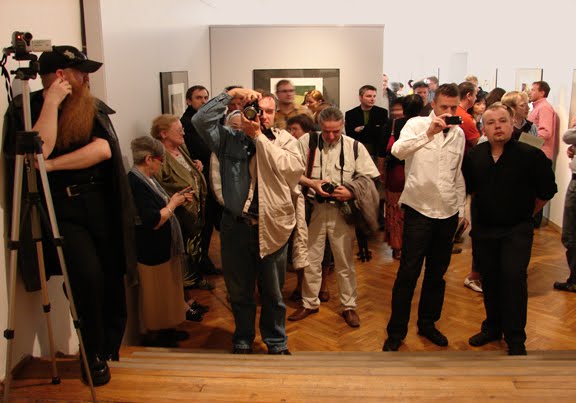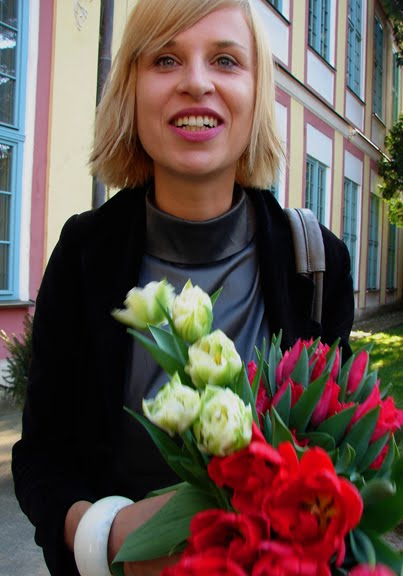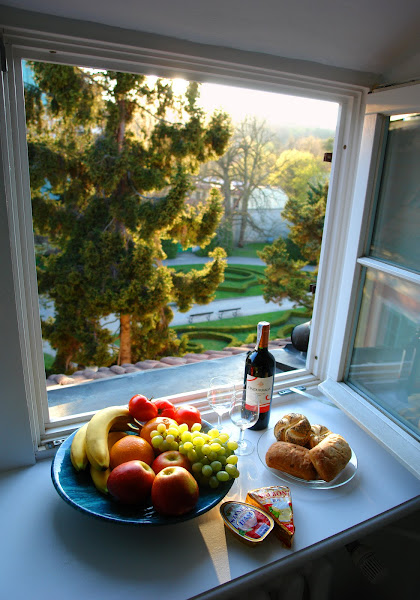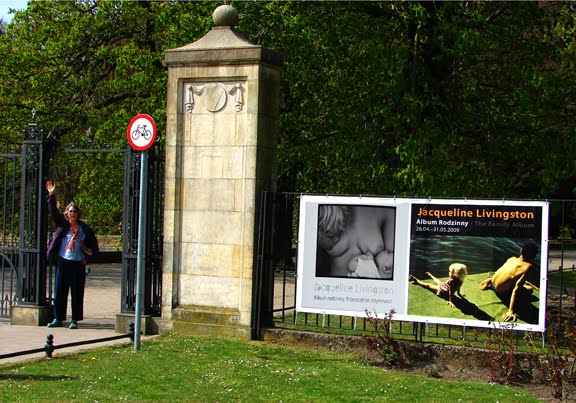@2009 by Jacqueline Livingston
My trip to Gdansk was one of the peak experiences of my life. My mind and conversations are still filled and will be for years to come, with all that my husband Leo Brissette and I saw and did there. Everything in those five days was a dream come true--only better. Nearly everyone involved in putting my exhibition together spoke English, so conversation flowed well and making friends was possible. The bonds we formed were as if from a life time.
The exhibition, titled “Spaces of Intimacy” was scheduled to run April 27 - May 31, but was so well received that the exhibition was extended to June 14. Every detail was taken care of. I had sent my twenty five 12 x 16 inch photographs matted (and printed by me), and the curator Mariola Balinska did a brilliant job of backing and framing them in 20 x 30 inch frames. She choose a dark-gray matt to back the color photos and a rich-brown for the sepia toned and had the gallery newly painted with one section of walls off-white and another gray to off-set the matting colors. The exhibition space and framing were so well designed they became a work of art in themselves. The work was hung in one enormous room and a second about half its size on the ground floor of Abbot’s Palace, one of three buildings in Gdansk that make up the National Museum. A third room smaller room was used to display one of my photographs projected wall size (about 10 x 15 feet) during museum hours.
The opening on April 26th was an enormous success with an unusually large gathering of nearly two hundred. After introductions, I was presented with a large bouquet of red tulips, and photographs were taken. Walking through the crowd, I sipped wine as I mingled, having warm conversations with some who spoke English.
The symposium the following day brought more attendees than expected and had to be moved to a larger room, where I presented another eighty images which included the fourteen posters of my son, his father and grandfather (all shown nude in numerous photos) that created my infamy in the late 1970’s. Malgosia Zwolicka, Head of the Photography Department, managed all the technical parts of Power Point for me. Ewa Majewska, Chair of the Gender Studies Program at Warsaw University, delivered an essay concerning feminist social philosophy, and issues of private/public power in the family and as it relates to my artwork, and Malgosia Paszylka-Glaska, Curator of the Department of Modern Art, spoke and gave an historical overview of the family as subject in art. Our interpreter did a splendid job.
After both the opening and the symposium, those of us closely involved went to restaurants for food, drink and much conversation. At times, because English was spoken and feminist issues were discussed, I forgot I was in Poland. It felt like we were amongst friends from the States--pretty amazing how really small our planet has become. Our technology allows us to travel easily both physically and electronically. Specifically, Mariola Balinska was familiar with my work due to her travels from Poland to the States, meeting my friend, New York photographic artist Barbara Yoshida who generously showed Ms. Balinska slides of my work (when she showed her own) and Ms. Yoshida maintained contact through her trips to Poland. In general, my work is known in Poland largely because of the Internet. Planning the show's details was possible due to email communication. In addition, many of the photographs taken by various photographers at the opening are available on their blogs.
The next day I was interviewed at the exhibition gallery by Polish TV news, and the following day I gave a half hour interview for a TV art program. Afterwards, Aleka Polis, an artist and writer from Warsaw, did a video of me as I walked through the exhibition and talked about many of my photographs. Her 8 minute video was published in the online art magazine http://www.obieg.pl/.
Leo and I were treated like royalty. We were provided a lovely fourth floor walk-up apartment on the top floor, really more like the attic, in Abbot’s Palace where my photos were being exhibited. Through two dormer-windows (very European) we looked out over Oliwa Park, one of the most beautiful parks we have ever seen, complete with a botanical garden, small lakes, waterfalls, streams, trees covered with pink and white spring blossoms, huge magnolias, and forsythia at their peak. Opposite this view, across our twenty foot room was a single large dormer that had a view of the main entrance to Abbot’s Palace where we could see one of two 5 x 6 foot banners announcing my exhibit. (The second was placed on the main gate to Oliwa Park.) And beyond that, rising against the skyline was Oliwa Cathedral, originally built in the 12th century with today’s interior dominated by an extraordinary organ over the main entrance which is one of the largest of its type in Europe. The apartment was stocked with cheeses, meats, vegetables, fruits, cereals, and drinks.
We were given guided tours to every place in our tourist guide books of Gdansk, including a private viewing of Hans Memling’s triptych “Last Judgment”, the pride of the National Museum, and St. Mary’s in Old Town, believed to be the largest brick church in the world (it can hold up to 25,000 people), though frankly right now it looks like the largest scaffolding construction in the world. We had the extraordinary experience to ride the construction elevator up the side of that scaffolding to the top of St. Mary’s 256 foot tower and once nearly to the top, climb further up two flights of scaffolding to a viewing platform overlooking all of Gdansk. Breathtaking! The tower was closed to tourist due to the construction. Had it been open, it was a 450 step stairway to the top.
Main streets of Old Town Gdansk were enjoyable. A tour guide walked us through shop after shop displaying amber jewelry and then along the waterfront, taking us through large stone gateways to municipal buildings, museums and Neptune’s Fountain.
Our hosts took us on several excursions. With Malgosia Zwolicka, her husband Rafal and five year old daughter, Amelie we visited the lovely and picturesque seaside resort town of Sopot. On another day with Mariola Balinska, her husband Marcin and eleven month old daughter, Julia we traveled an hour outside the city to one of the largest castles in Europe, Malbork which reminded us of Renaissance Fair grounds that we have frequented in the States. On the return to Gdansk, we stopped at the childhood country home of Marcin to meet and have tea with his mother.
We enjoyed wonderful food everywhere, eating in great restaurants, bakery and coffee shops for breakfasts, and meals at both Mariola’s and Malgosia’s homes was special, enjoyed with their families. We shared frequent breaks for tea, one tea of which I was so found that they sent it home with me as a gift. Additionally I was given gifts of amber jewelry as keepsakes from my new dear friends, the three women curators who made our visit to Gdansk outstanding.
Gdansk is the first city that Hitler wanted, both for its seaport and the fact that before it became part of Prussia after World War I, it was Germany’s. It was in Gdansk that the first shots of World War II were fired. Everywhere we went there were photographs and talk of Gdansk’s reconstruction after the War; a war that remained very much a part of the Gdansk psyche. In the reconstruction, what bricks could be reused were. Their contrasts when placed next to new bricks was striking and made for telling walls throughout Gdansk, appearing as scars that punctuate memories and serve as reminders of World War II.
And on the last day, we were all to meet for tea at the Curator’s office in Abbot’s Palace to say our goodbyes. Mariola’s husband, Marcin misunderstood what was happening, came to pick us up too early, did not know about the scheduled tea, told us plans had changed, took us to the airport, and since we were early for our flight, we stopped for tea and biscuits and a walk around a very posh shopping mall.
Everyone waited for us to come for tea at Abbot‘s Palace--Mariola Balinska, and her baby Julia (who was nearly always with her due to nursing), Malgosia Zwolicka and her daughter Amelie, and Malgosia Paszylka-Glaska waited for us at Abbot’s Palace. When they realized that Marcin must have mistakenly taken us to the airport, and since he had left his cell phone at home and could not be reached, they transported themselves to the airport (ten miles), arrived just before we did, were paging us, and met us as we stepped out of the car. What a surprise! The three women and the two daughters all smiles, standing in a line waiting for us. We hugged, and laughed about the mistake, went into the airport and had tea and biscuits a second time, and said our fond farewells.
We were in England for a week, staying with a friend south of London in Selsey, spending a day in Brighton, a day in London that included seeing the Tate Modern across the Millennium Bridge from St. Paul’s, riding and photographing from the top of a double-decker bus all the way to the House of Parliament and Westminster Abby, returning back to our airport hotel and leaving for Maui the following day.
I was back in Maui about a week when Ewa Majewska emailed asking if she could use my photograph of “Vinceanna Nursing Vajra and Bell” (which was reproduced on the announcement the National Museum circulated for my exhibition) on the cover of her book that was waiting publication in September 2009 titled Feminism as Social Philosophy. Essays on the Theories of the Family. After its publication Ms. Majewska emailed me saying, “After your exhibition I gave an interview for a Warsaw based TV, and the journalist also seemed to be very inspired by your work and (if I can say so:) by my approach to it somehow too...and everybody loves your picture I now have on the book cover... and many people say it is so good to see the word "feminism" with this very picture - it takes away all the stereotyped images of feminism as mainly aggressive...”
In October 2009 Ewa Majewska’s essay on my photography (that she delivered at our symposium on April 27th in Gdansk) was published in the feminist section, Artmix, of the online magazine http://www.obieg.pl/ along with five photographs from the exhibition.
At a future date, Mariola Balinska, the primary curator of my exhibition “Spaces of Intimacy”, will publish in http://www.obieg.pl/ an interview with me concerning my 1960’s involvement in the feminist movement.
Scroll past the "comments" section to see my 5 photos taken at Gdansk:
"The Team," "Opening Crowd", "Bouquet of Tulips from Mariola", "Perfect Welcome", and "Waving Next to My Banner at Oliwa Park".
Sunday, October 18, 2009
Subscribe to:
Post Comments (Atom)





Dear Jacqueline!
ReplyDeleteso nice to read your memories/reportage from Gdansk...
I was so very inspired by the conversations we had just after the opening... and by the whole correspondence that we had afterwards...
I hope the English version of my text will be ready soon. And - good luck with the blogging, I can't wait to read and see more again!
Dear Jacqueline,
ReplyDeleteWhat an incredible exhibition and wonderful experience, the photographs of you are a breath of fresh air. For many years I have the piece you gave me from your dinner party framed and in a very central location in our parlor/my studio. It always gives me a feeling and belief in the Divine Feminine.
Continued Success!
C
www.cbangs.com